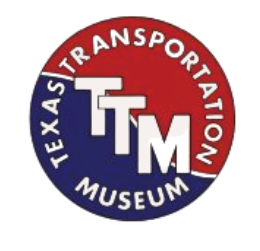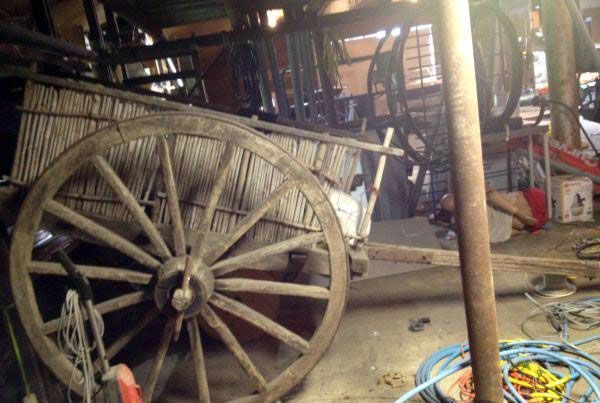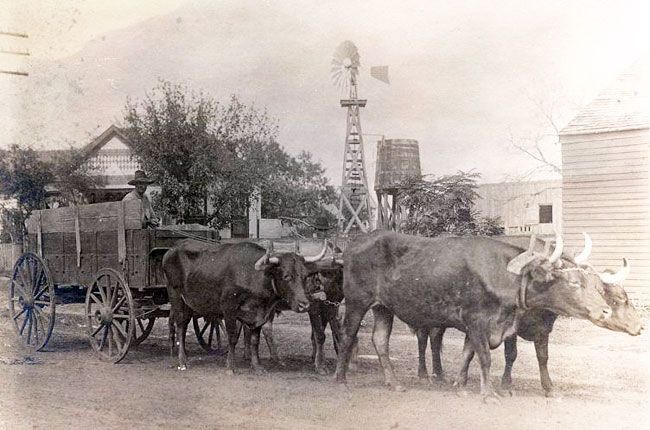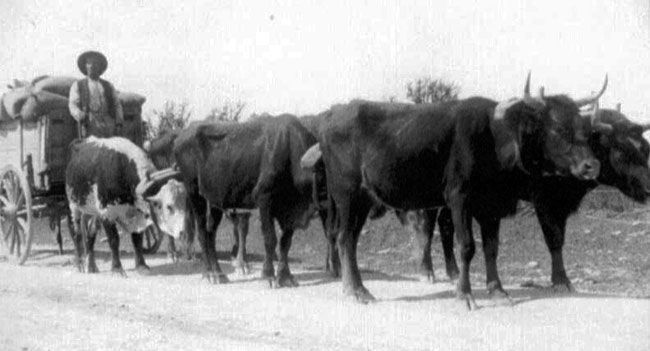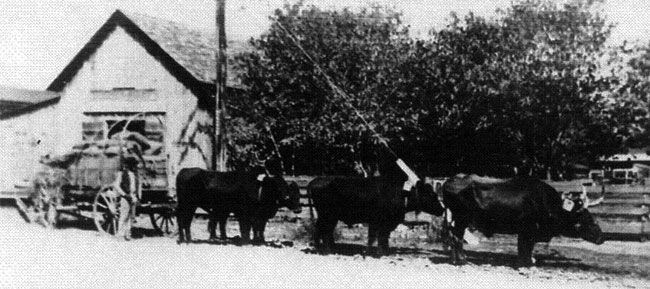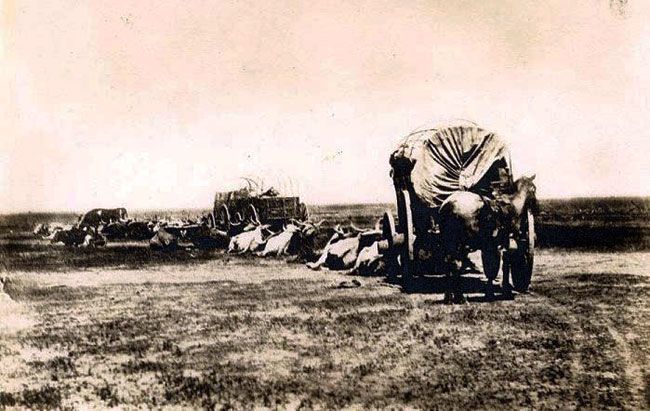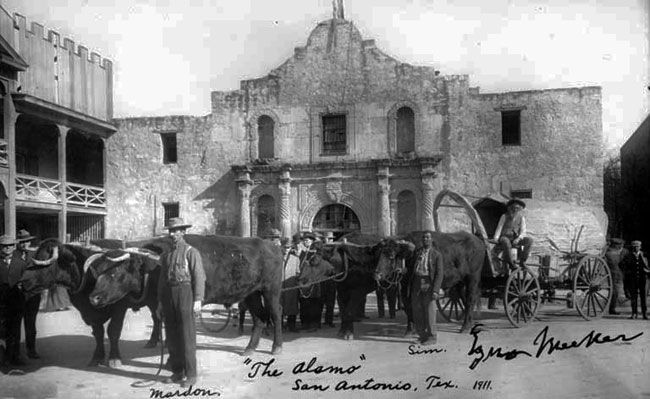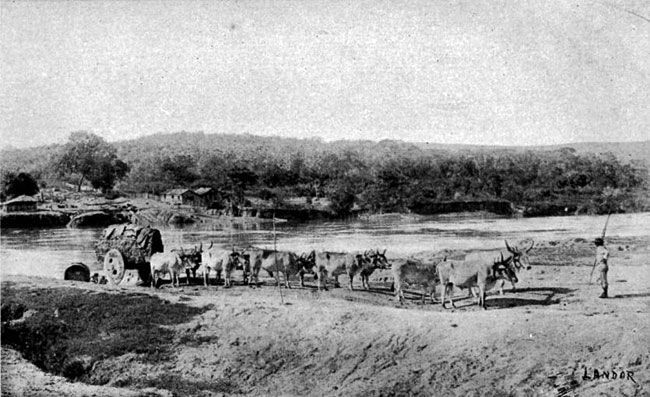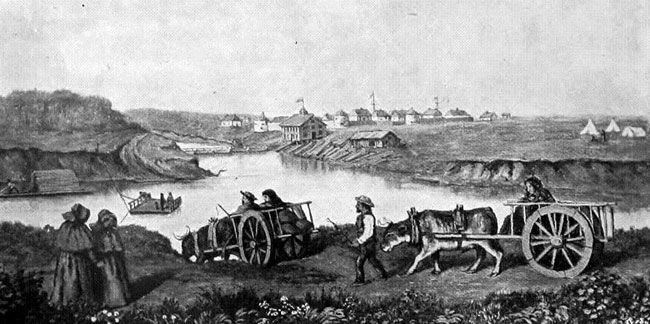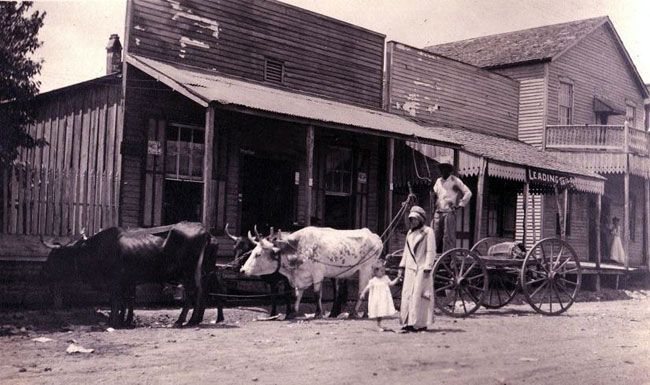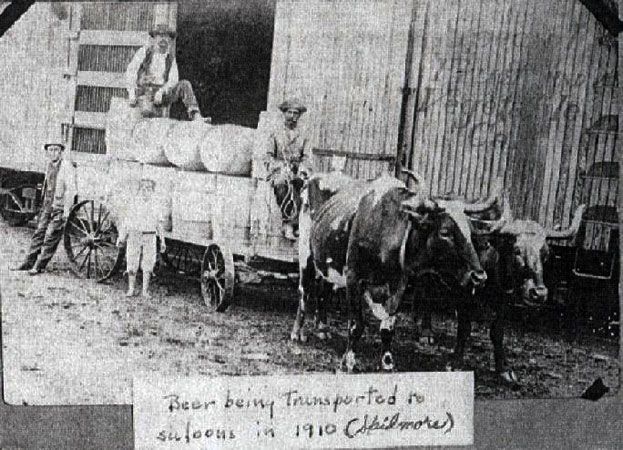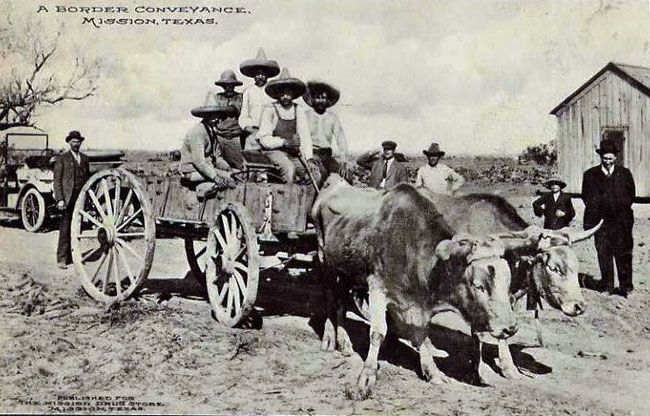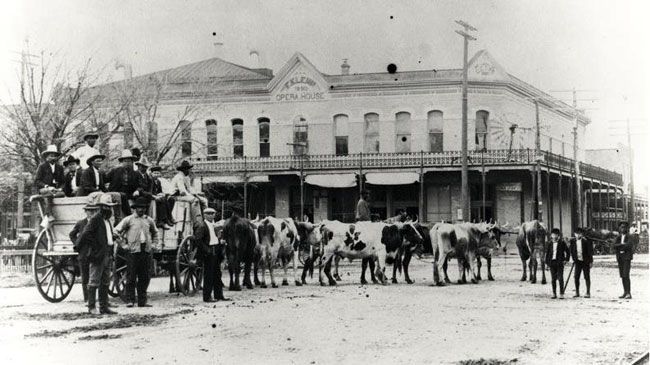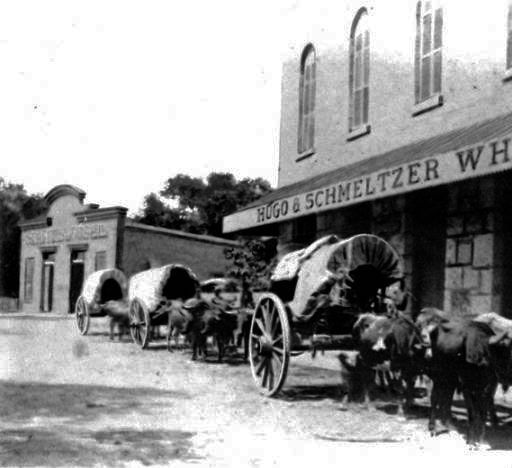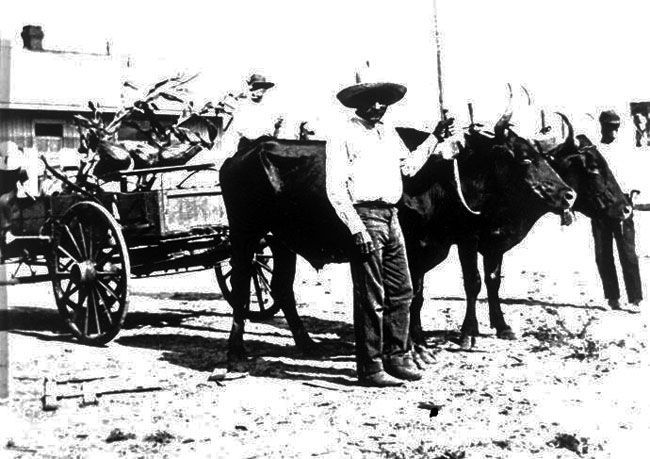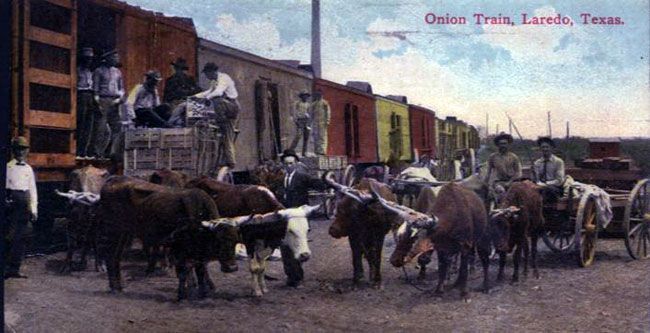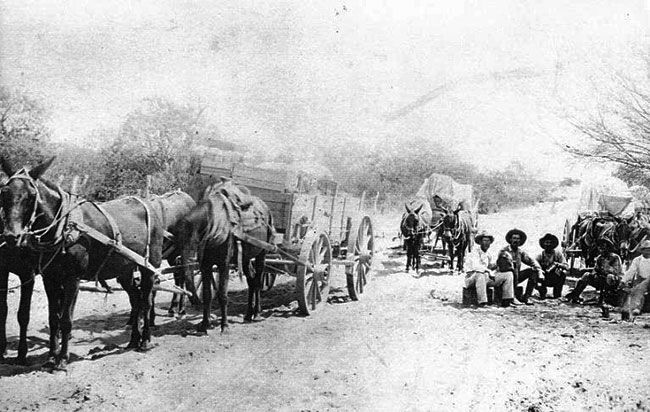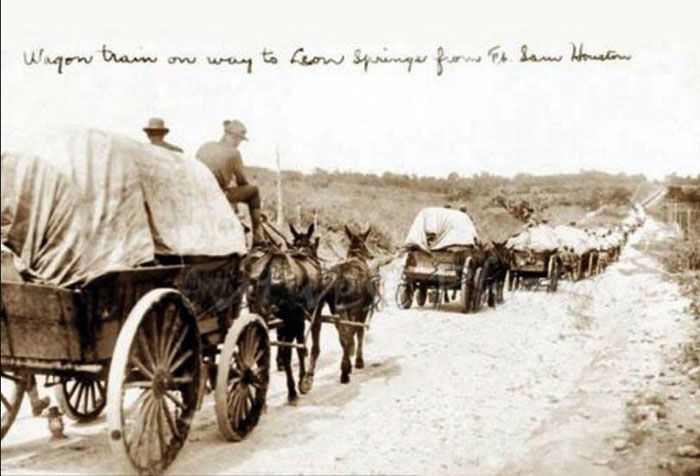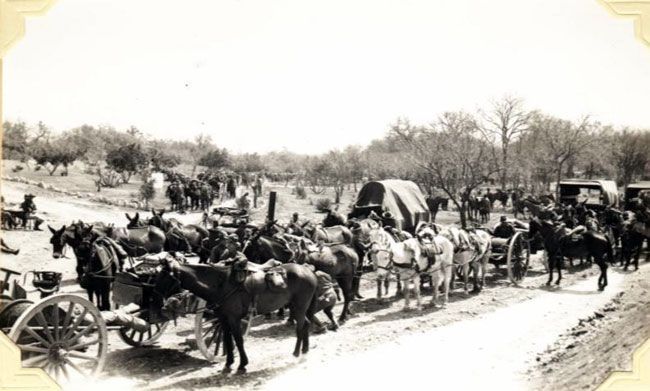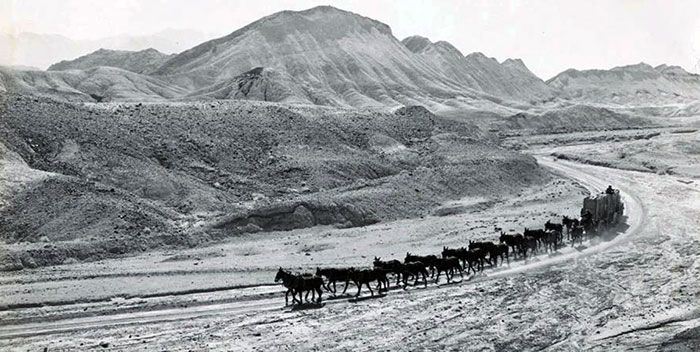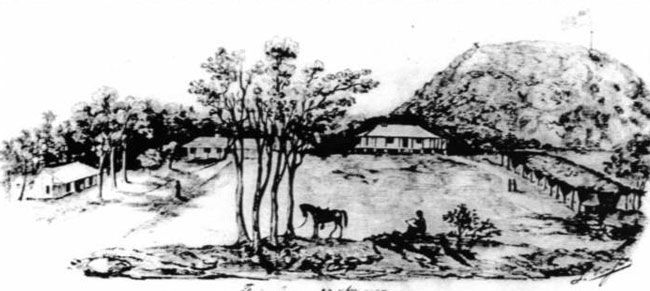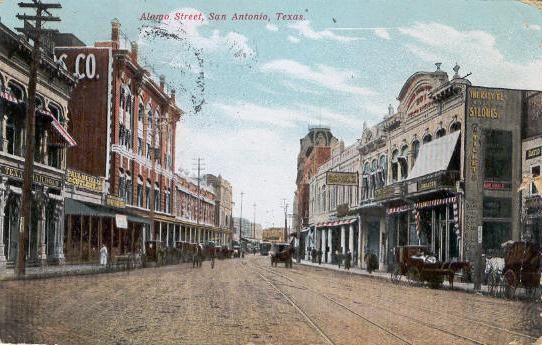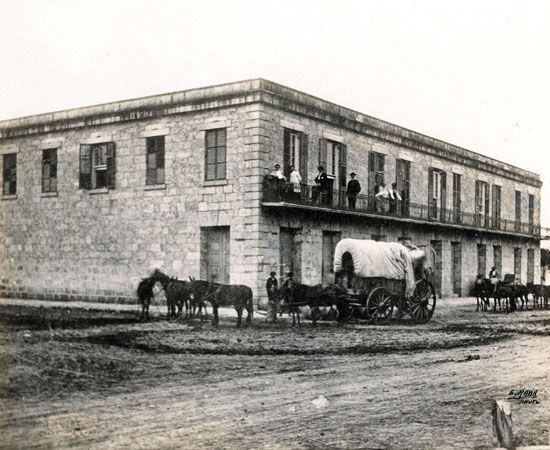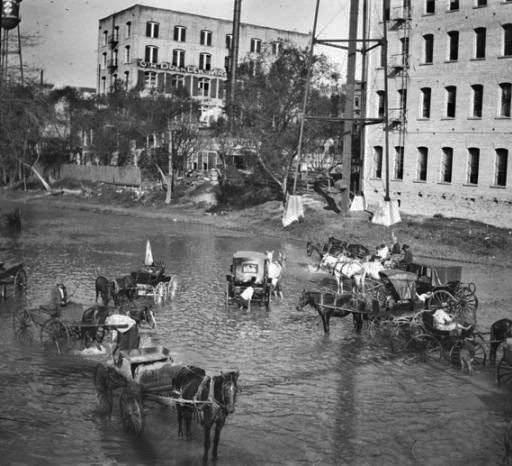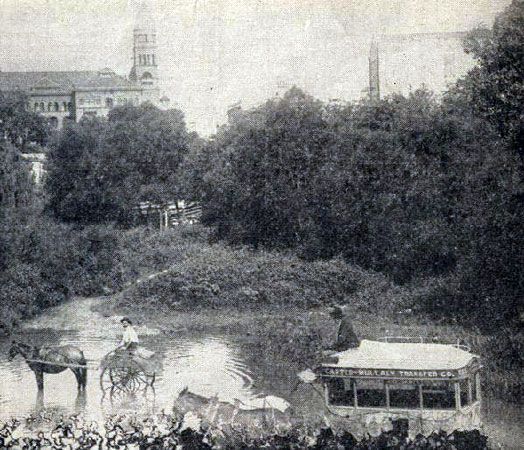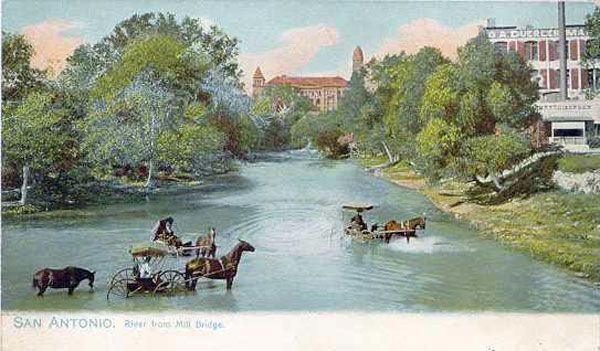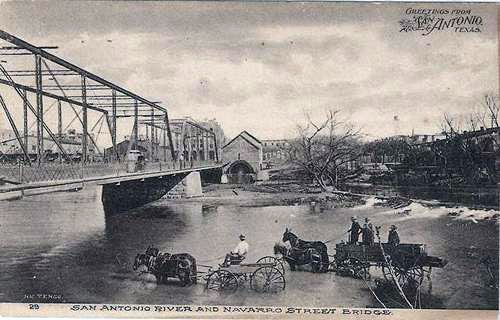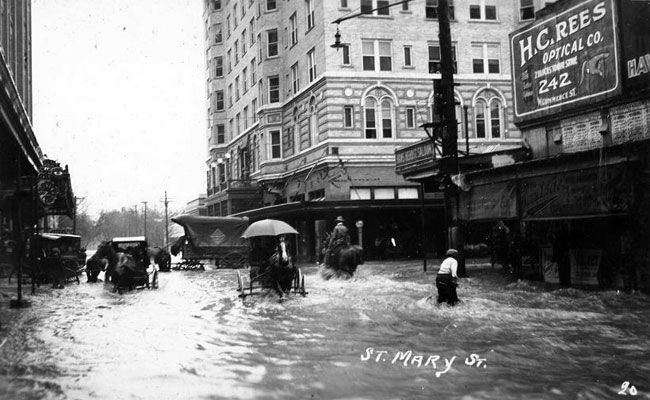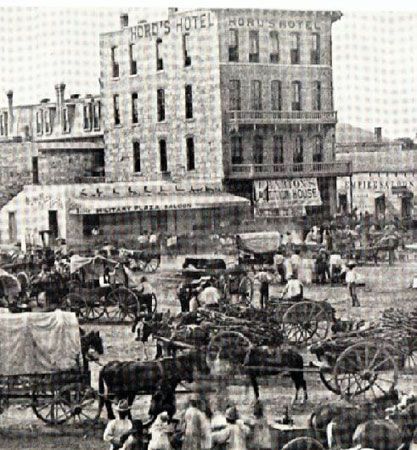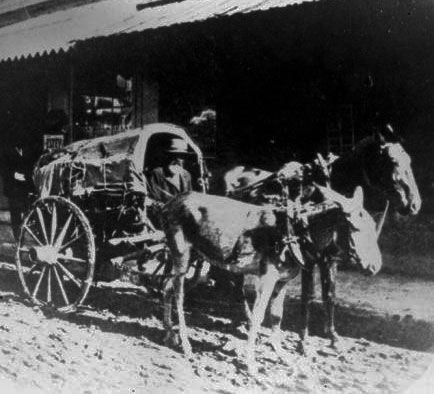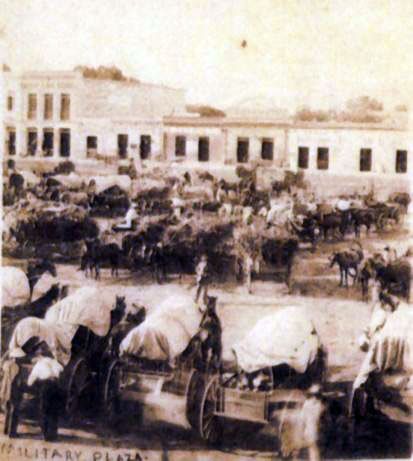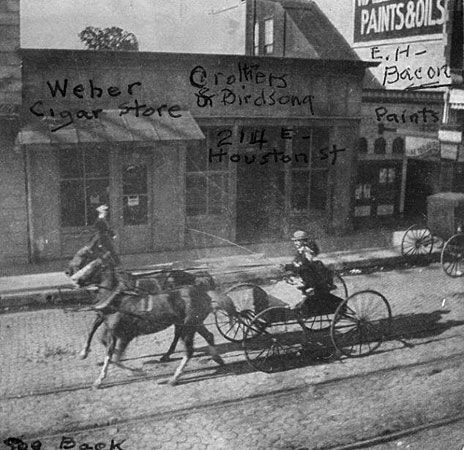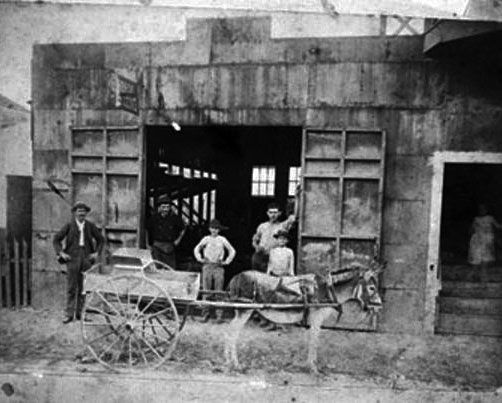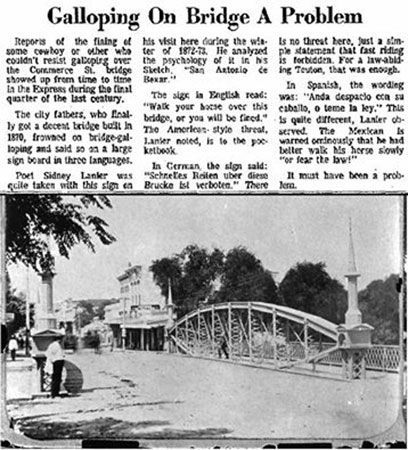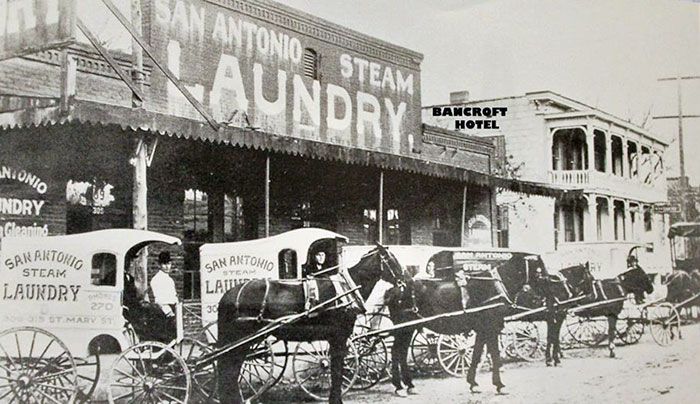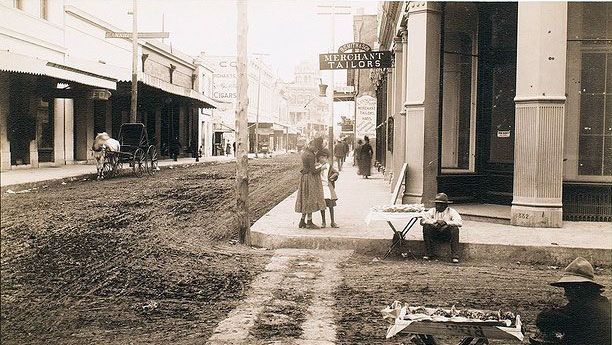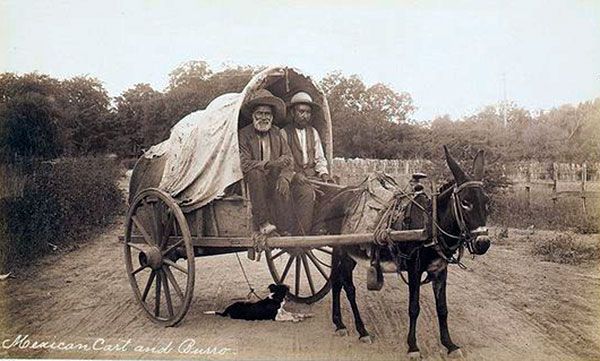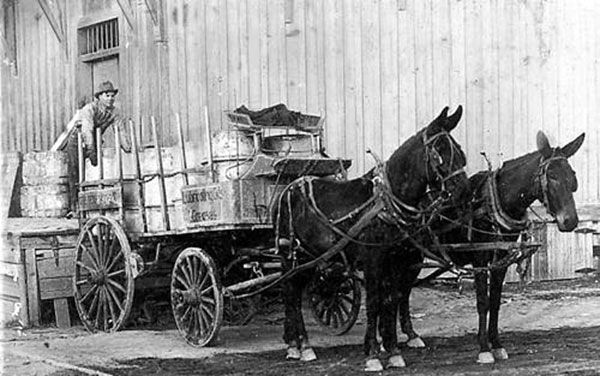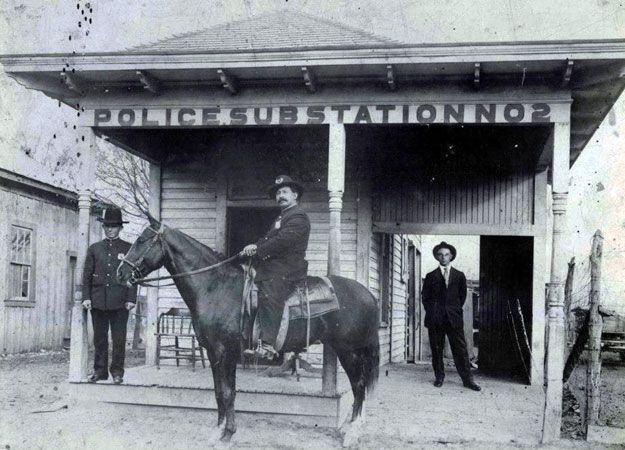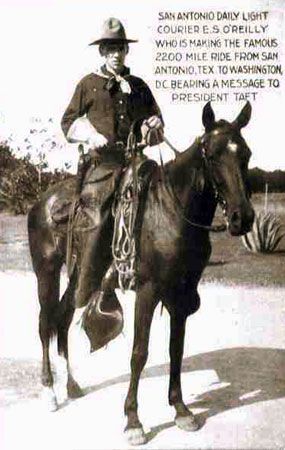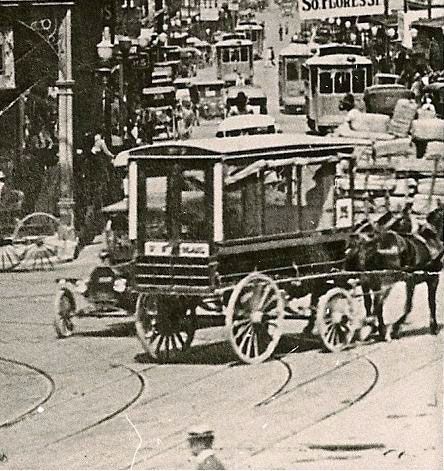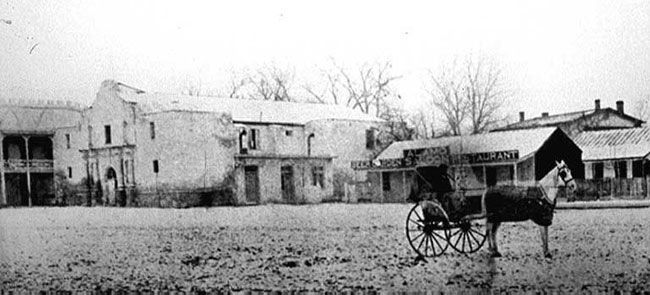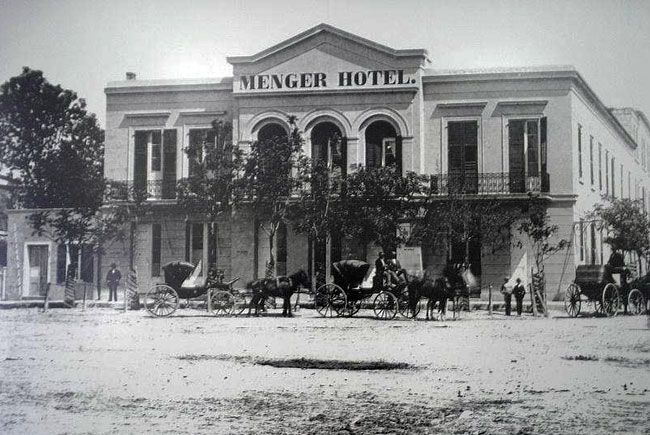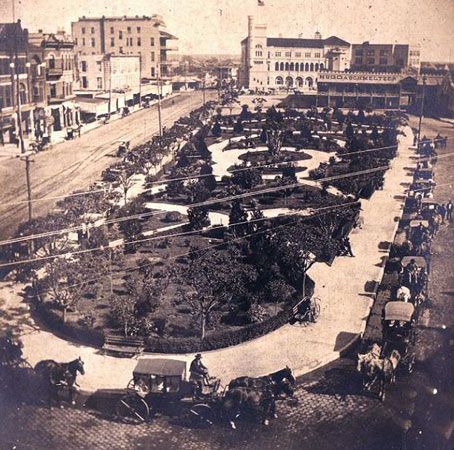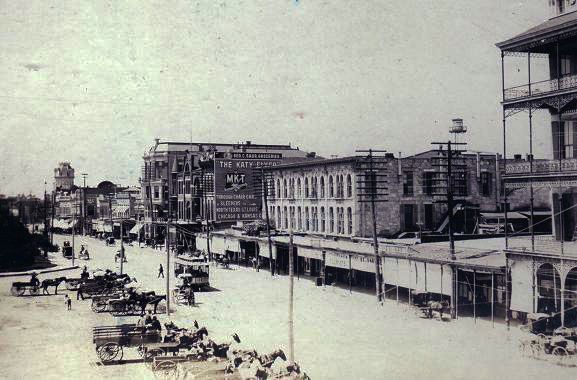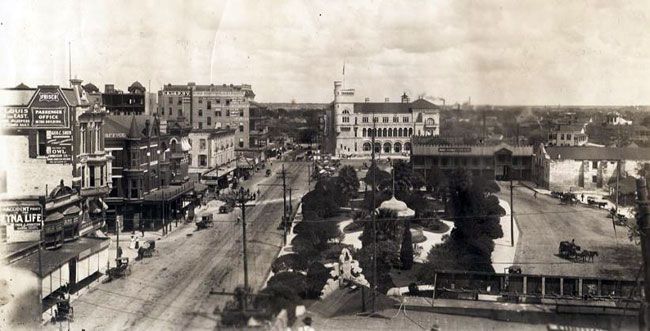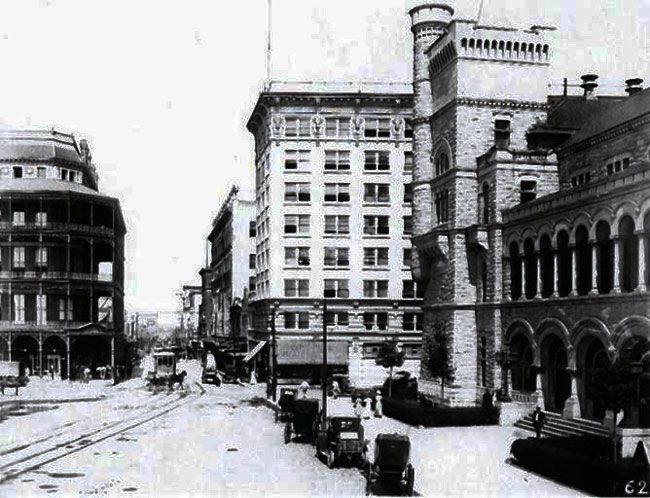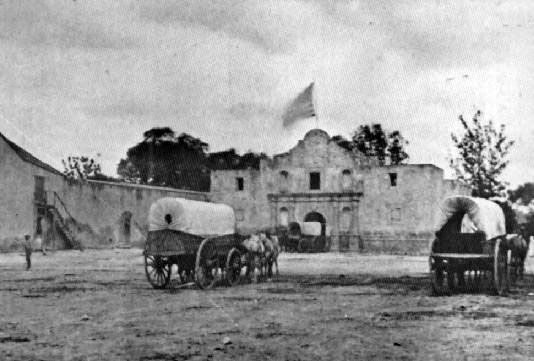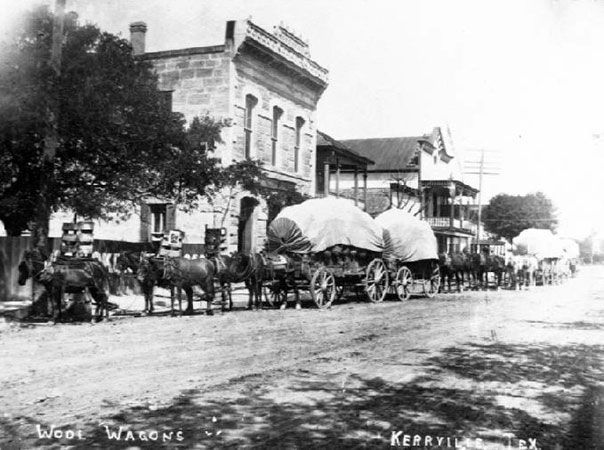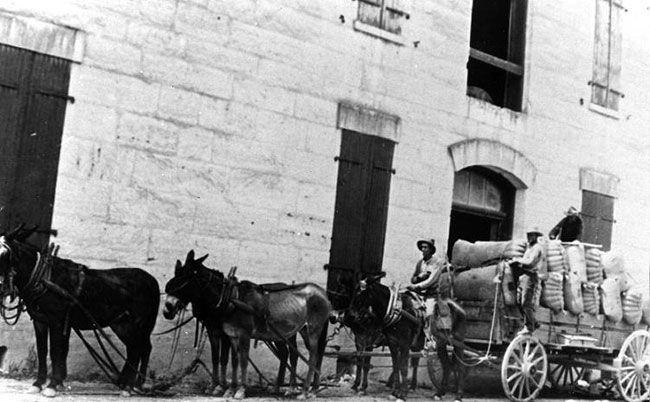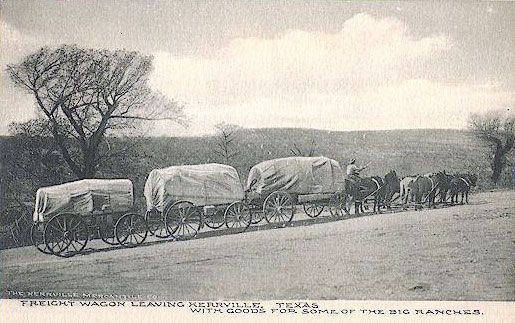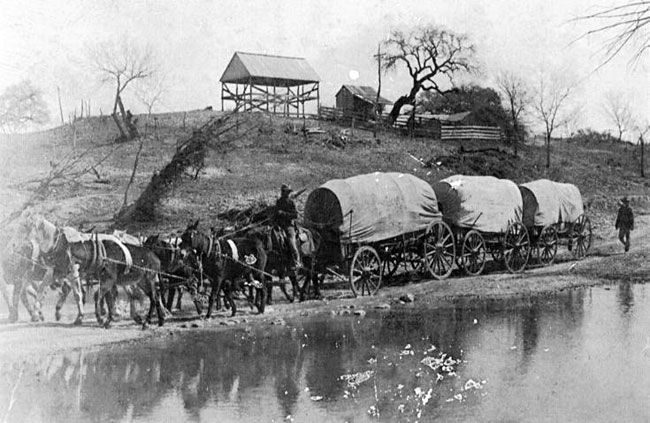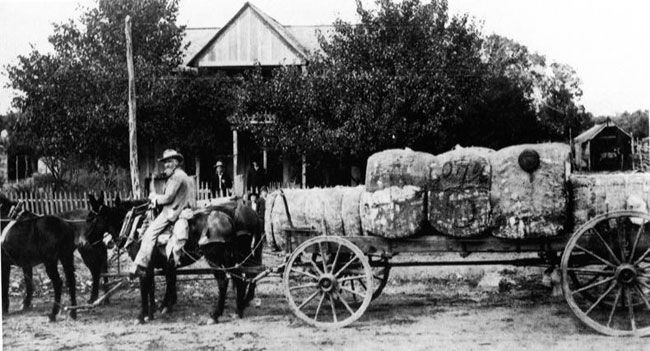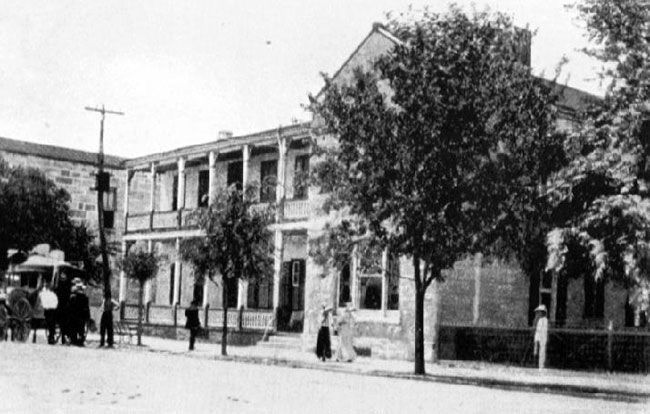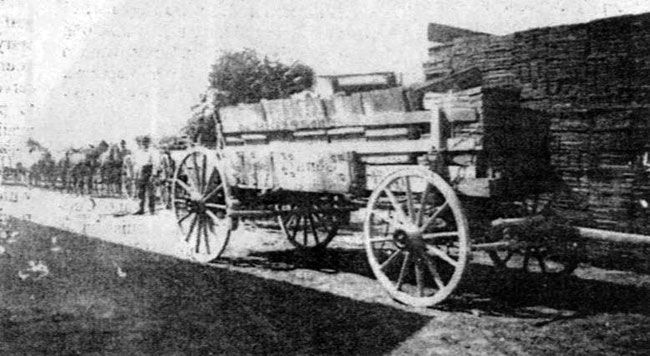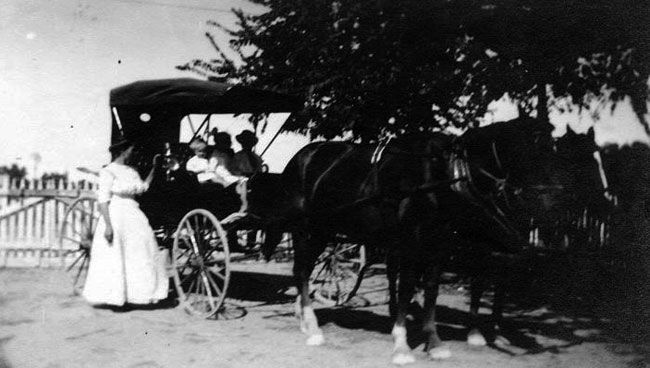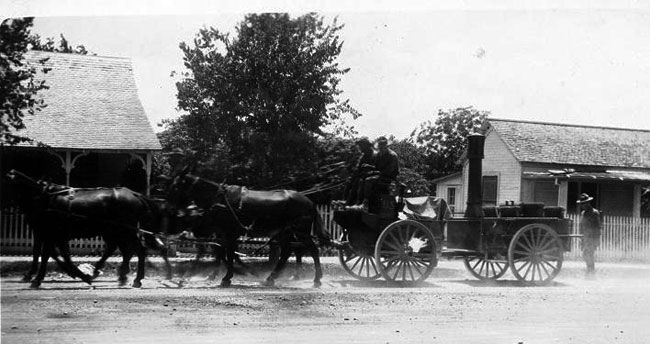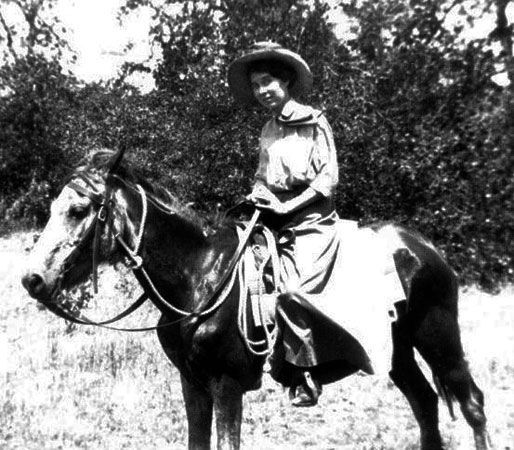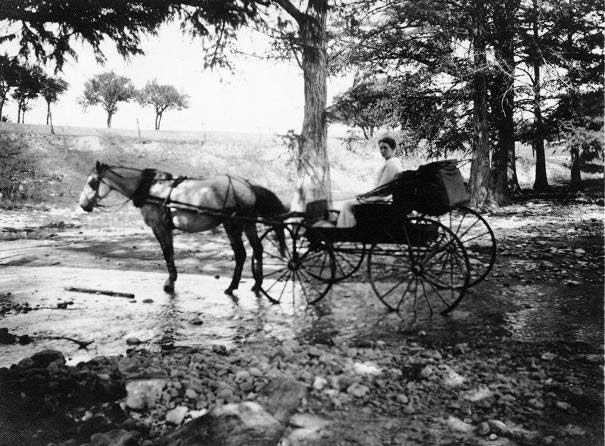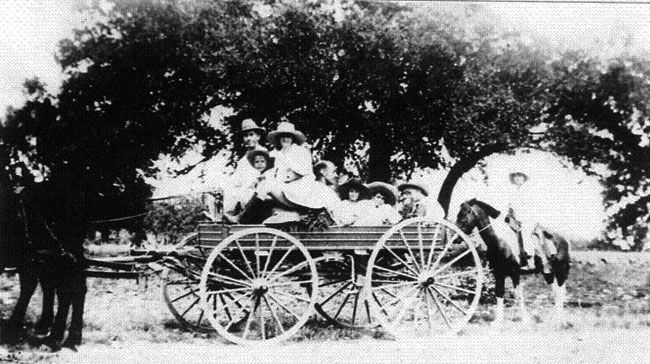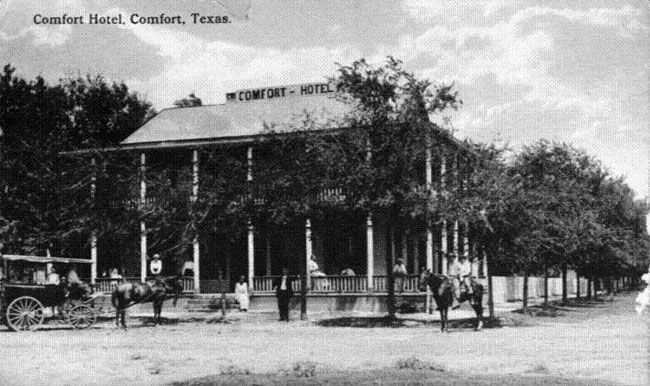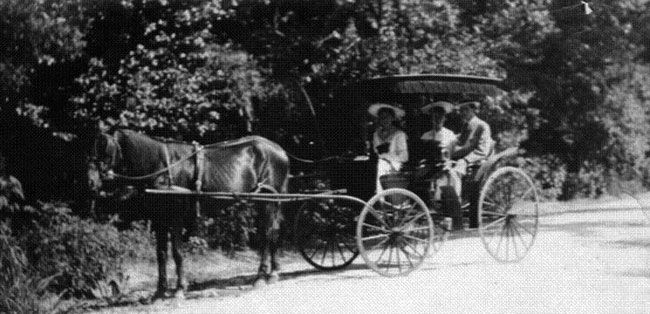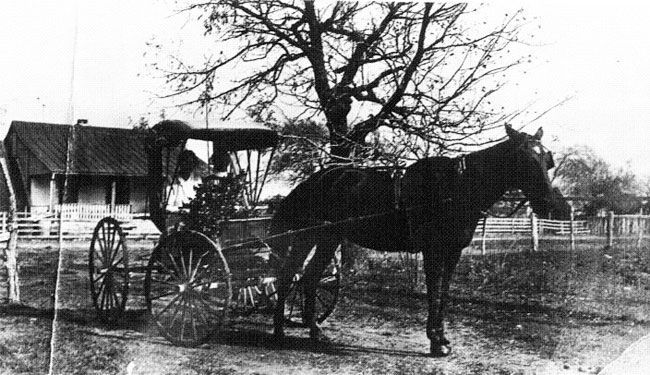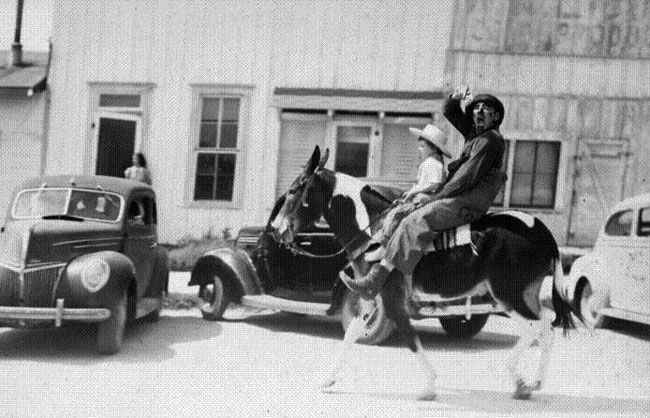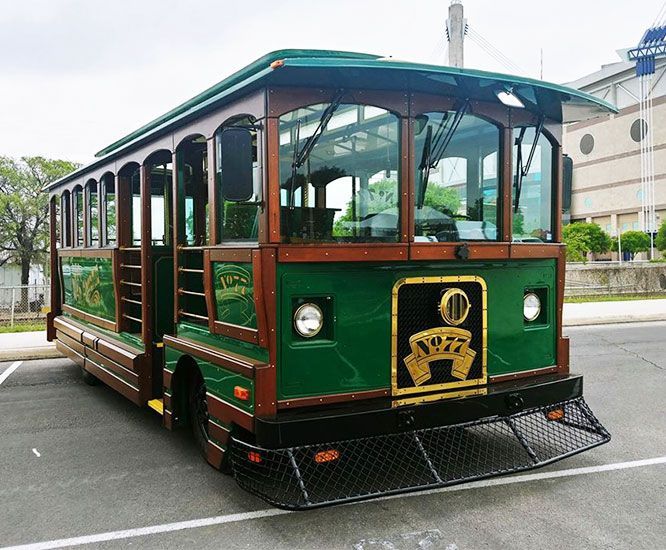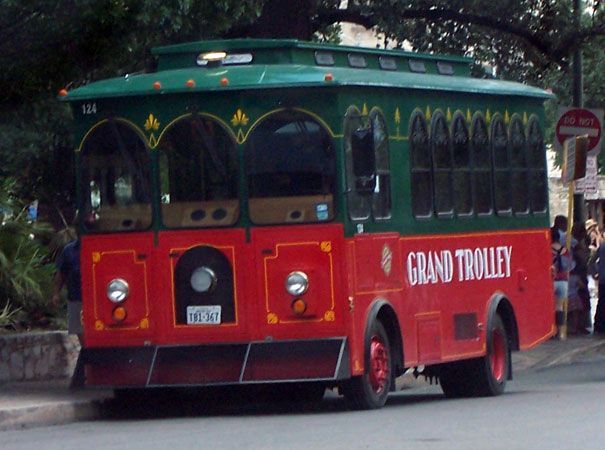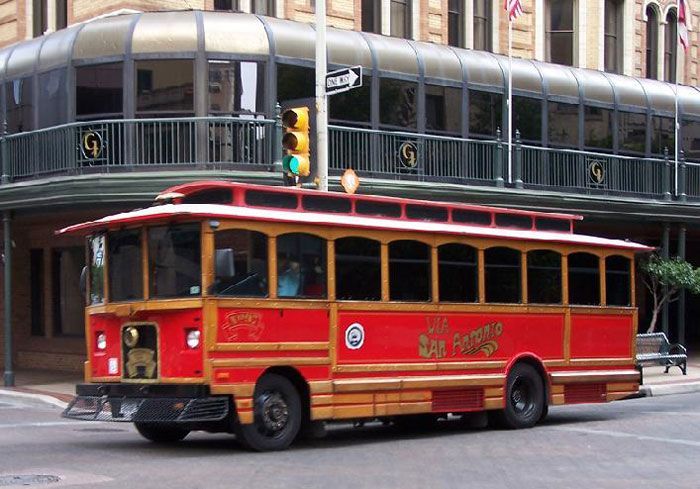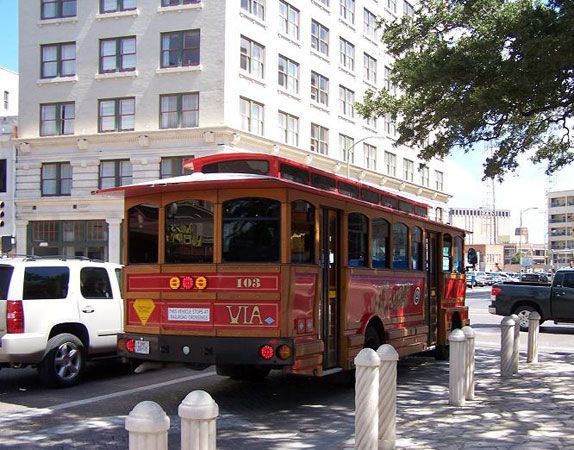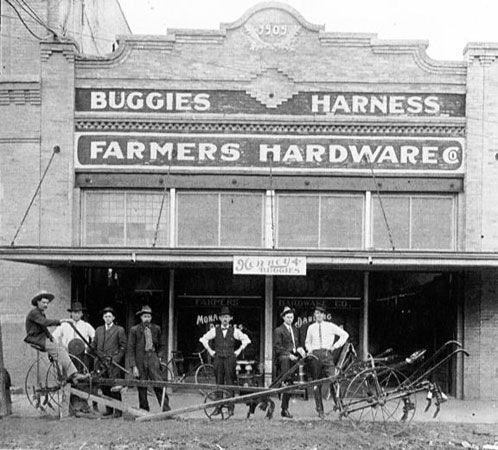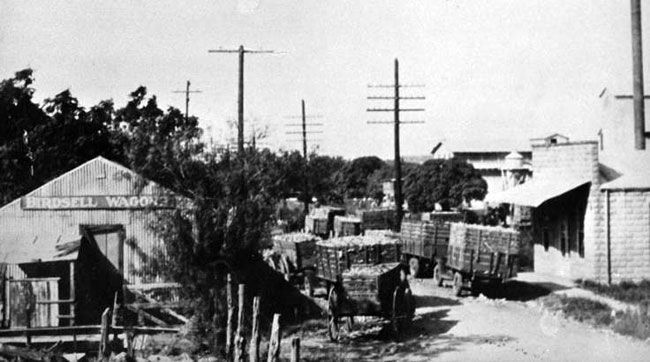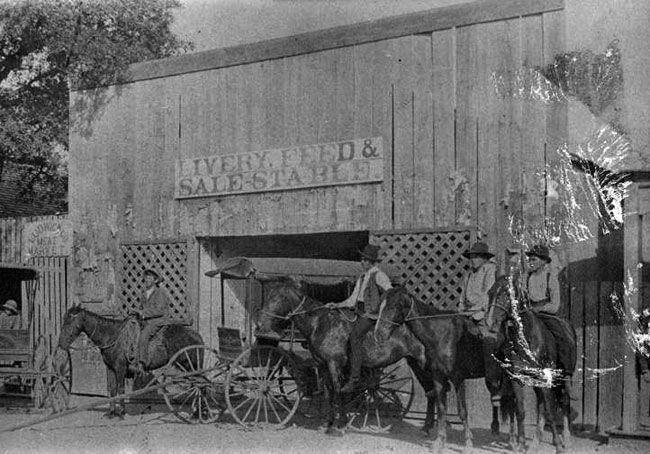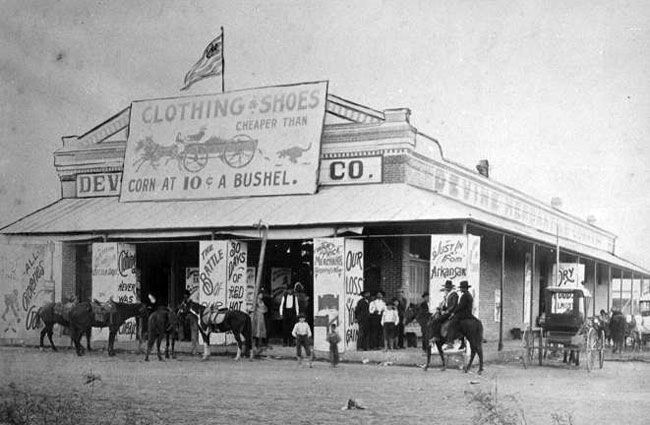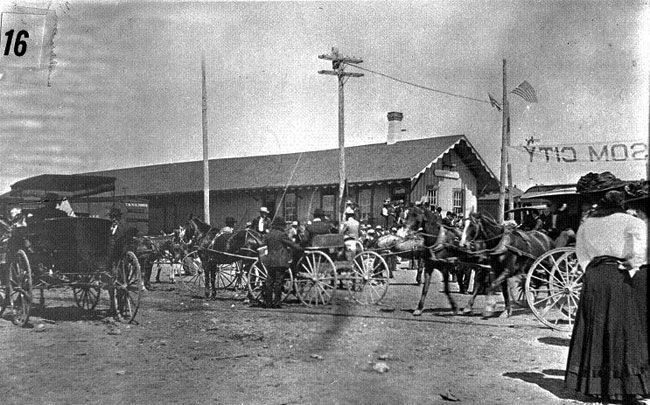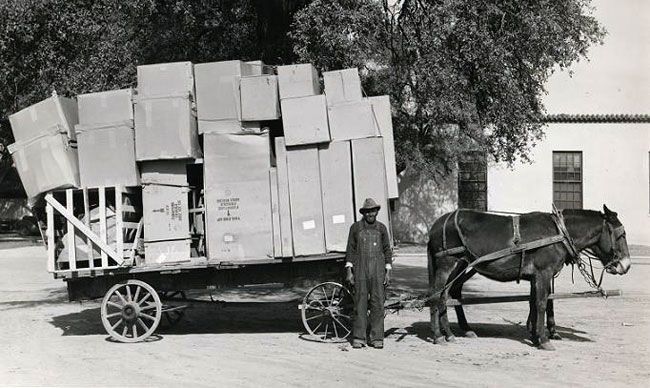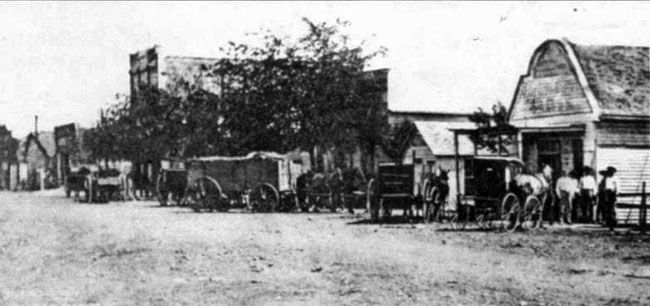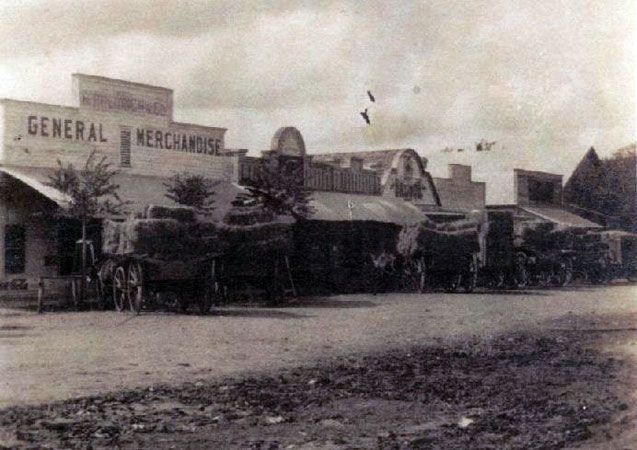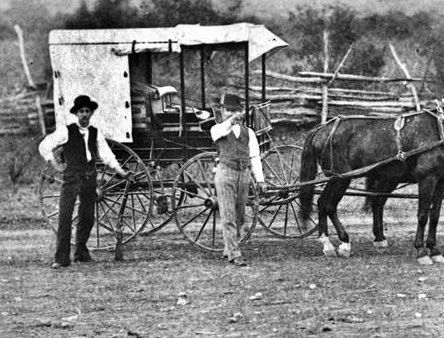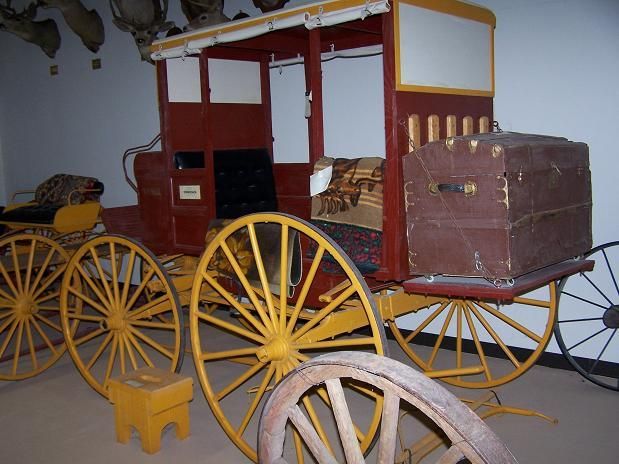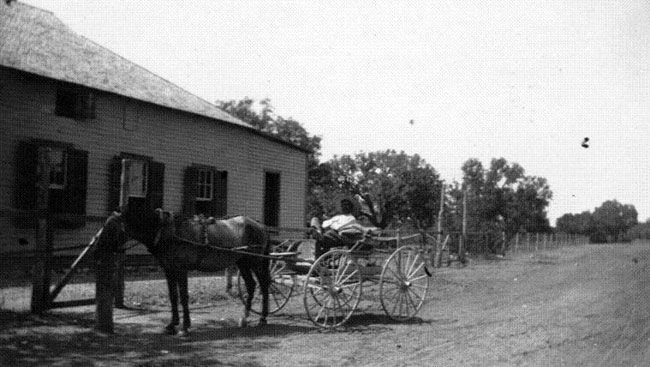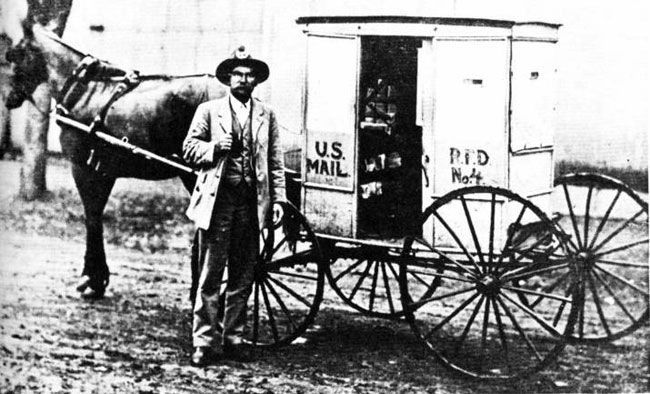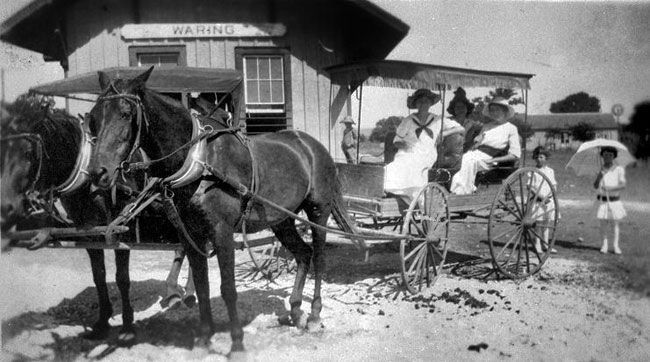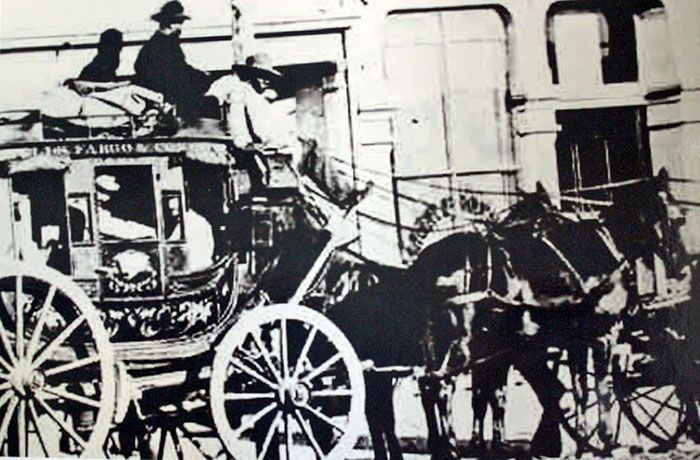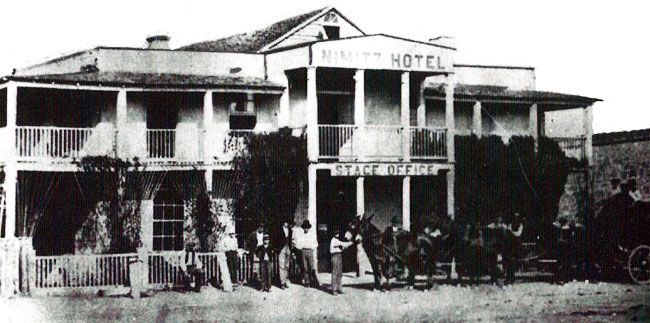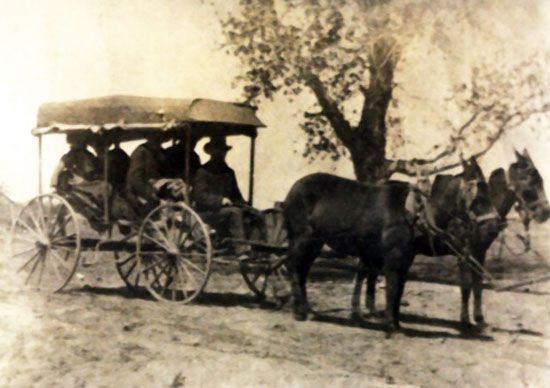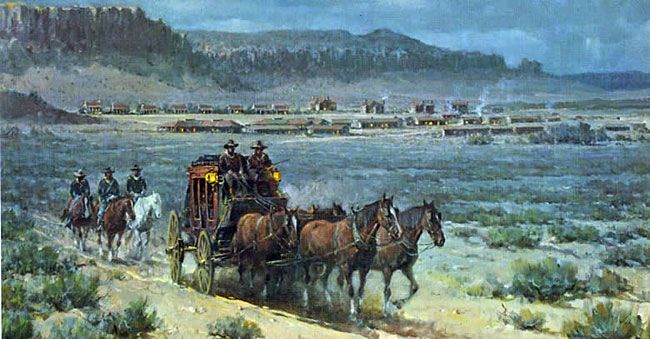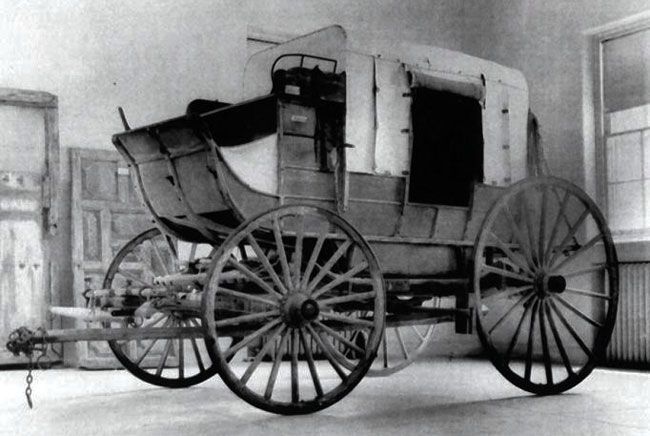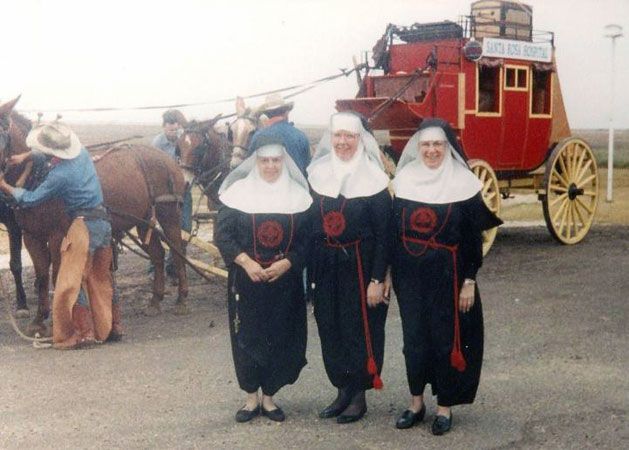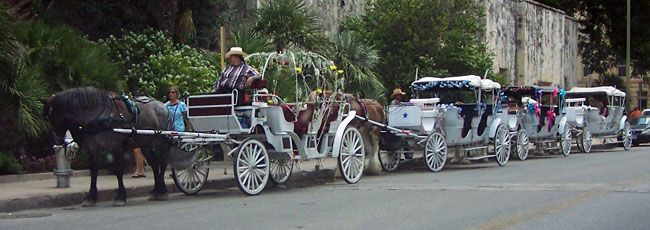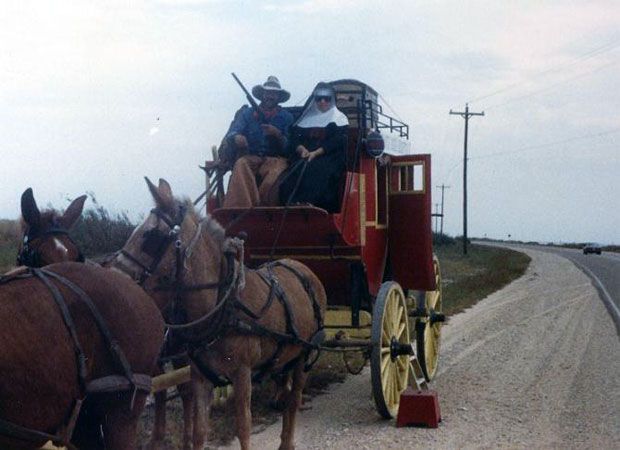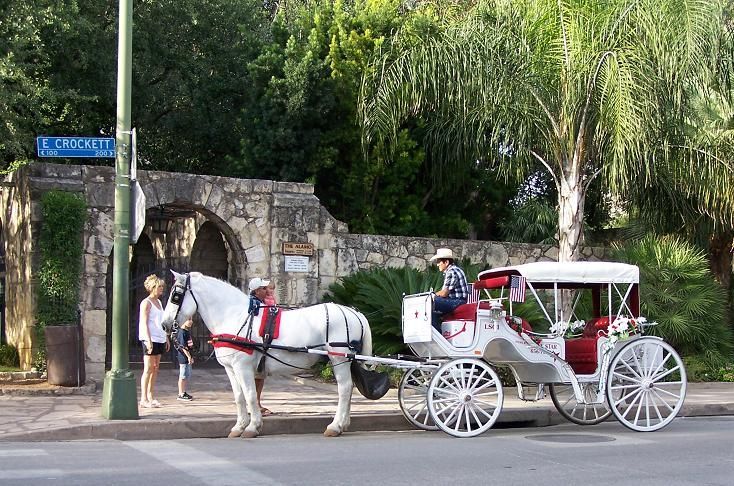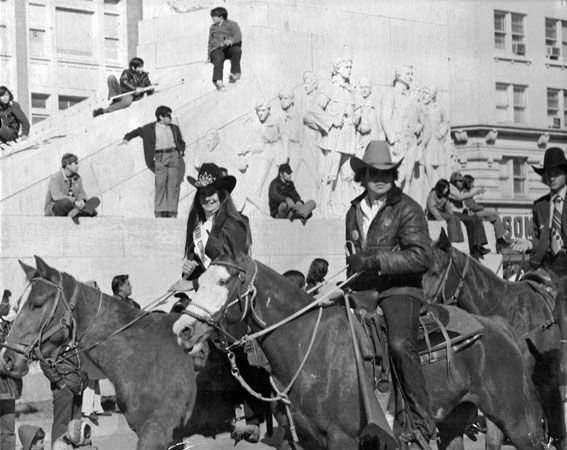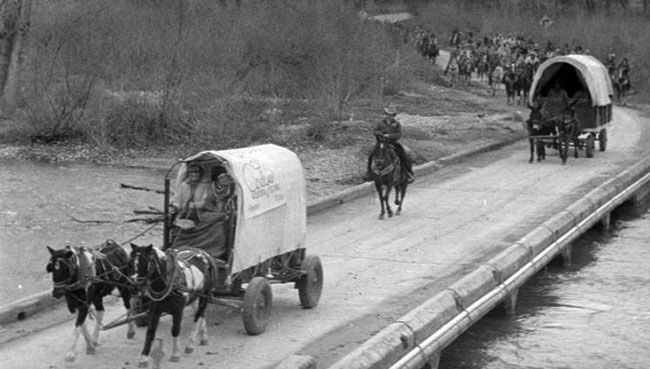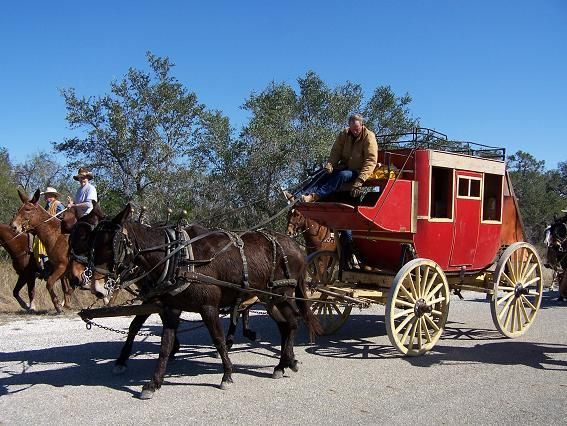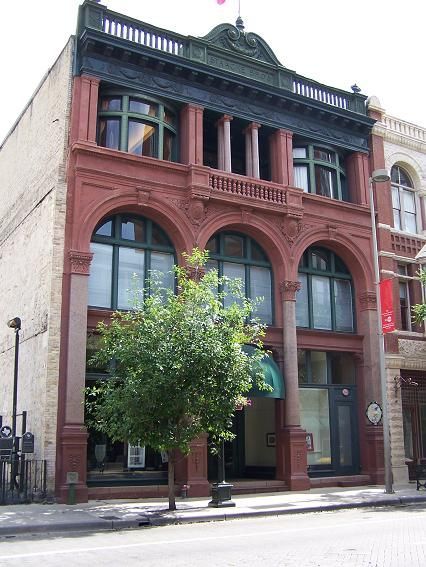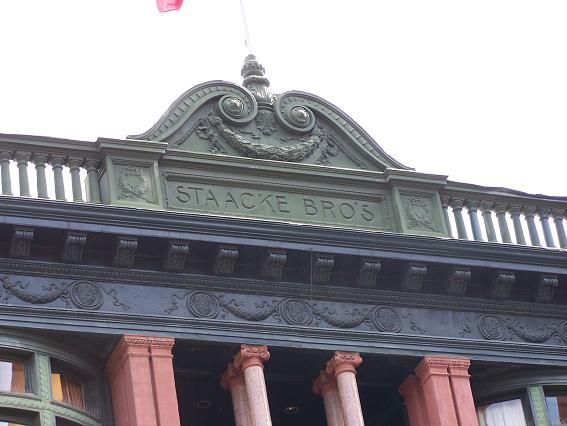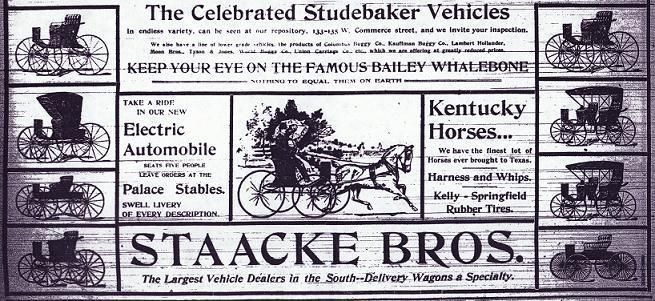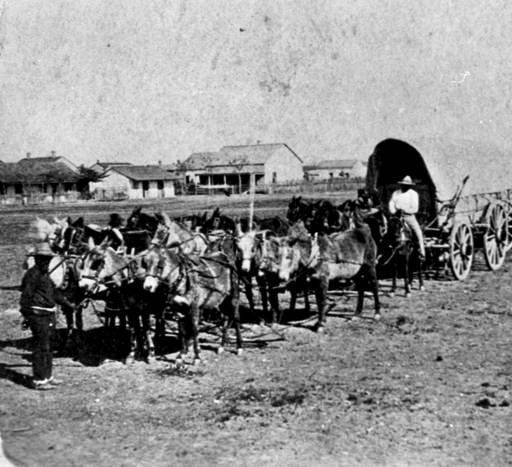San Antonio Transportation History Ox, Mule, and Horse Drawn Era 1845 - 1910
Mexican Style Ox Drawn Cart or Carta
Until Texas became part of the USA in 1845, travel to and from San Antonio was conducted in large carts, with two solid wooden wheels. Although these were most often individually owned they traveled together in large train of up to thirty wagons, each one pulled by up to ten oxen. The main crossing over the Rio Grande was near modern day Eagle Pass. San Antonio was almost exactly half way to Nacogdoches at the border of Louisiana although by 1836, when Texas gained its independence from Mexico, that city had been abandoned and there were only around two hundred people living east of San Antonio in the entire state.
Ox Drawn Carts and Wagons
These early wagons were crudely but solidly built from local materials. They used almost no metals parts. Their solid wheels were seven feet in diameter, set seven feet apart. The beds were six feet wide and sixteen feet long and usually shaded. Carefully balanced, they were capable of hauling 5,000 lbs of freight. They were incredibly slow, capable of only ten miles day under good conditions. It took almost two weeks just to make it to the border.
Ox Drawn Carts and Wagons
By 1836 when Texas gained its independence San Antonio's population had fallen from a peak of around six thousand around 1800 to under one thousand. When Texas became a state in 1845, two very important factors revitalized the city and the surrounding area. The US Army arrived and soon established a series of ten forts to the west of the city, to maintain the newly established border with Mexico and quell the lawlessness in the region that reached almost epidemic proportions, with a vicious amalgam of displaced, very angry, native American tribes and outlaws luxuriating in one of the remaining unpoliced parts of America.
Ox Drawn Carts and Wagons
The second influence was the US Postal Service. This involved the federal government in the creation and maintenance of a road network. Civilian contractors took supplies to the various forts and, with the prospect of protection, civilian communities were developed near each fort. A case in point is Uvalde, which was established near Fort Inge, which protected the Woll Road, named after the last Mexican general to occupy San Antonio in 1842.
Wagons Trains in South Texas
Along with the influx of Northerners came sturdy four wheeled wagon using two axles and, just as importantly, mules. Using this combination, more freight could be carried more quickly. The wagons relied on seasoned wood from northern climes. Any other wood would simply dry up and shatter in the heat of Texas and the punishment dealt out by the primitive roads.
Mules, Horses and Wagons in San Antonio
Mules had advantages over both oxen and horses. Bred from a female horse and a male donkey, the animals were about half way in size between the two. They were strong and sure footed. They lacked the free spirited nature of horses and were, indeed, creatures of habit. A good caporal, the name given to the person in any wagon train in charge of the animals, had only to crack his whip in the morning for the mules to line up not only in front of its assigned wagon but even its assigned place within the team, with could consist of between six and eight animals. Unlike oxen, they did not rely entirely on foraging for the food but had to be fed from foldaway troughs at regular intervals. Their skin could withstand a lot of chafing from pulling heavy loads but was not water proof. They did have one huge disadvantage over oxen. The latter interested thieves not at all while mules were highly prized plunder.
Mules, Horses and Wagons in San Antonio
Mules had advantages over both oxen and horses. Bred from a female horse and a male donkey, the animals were about half way in size between the two. They were strong and sure footed. They lacked the free spirited nature of horses and were, indeed, creatures of habit. A good caporal, the name given to the person in any wagon train in charge of the animals, had only to crack his whip in the morning for the mules to line up not only in front of its assigned wagon but even its assigned place within the team, with could consist of between six and eight animals. Unlike oxen, they did not rely entirely on foraging for the food but had to be fed from foldaway troughs at regular intervals. Their skin could withstand a lot of chafing from pulling heavy loads but was not water proof. They did have one huge disadvantage over oxen. The latter interested thieves not at all while mules were highly prized plunder.
Mules, Horses and Wagons on Alamo Plaza in San Antonio
As the population grew and new communities developed, San Antonio became a huge trading center. Commerce Street was thronged with wagon trains arriving and departing. The historic plazas became grazing and marshalling areas for hundreds of oxen and mules. Warehouses up and down the street accepted deliveries and saw to their further distribution. Merchants set up shop near this area and the city began to radiate out from one of the busiest trade centers in the state. Blacksmiths, saddlers, livery services, wagon manufacturers and outfitters added their distinct aromas to what must have been an already ripe ocean of odors.
Mules, Horses and Wagons in Kerrville, Texas
After the civil war an improved form of wagon, the "Prairie Schooner" was introduced. These were usually painted blue with white canvas tops that were said to resemble sails from a distance. The wagons were built for hard use over tough terrain. Unloaded, they weighed 4,000 pounds. They had five feet ten inch diameter spoked rear wheels and four feet ten inch front wheels both with thick, wide, iron tires. The beds were twenty-four feet long and four feet six inches wide with sides that were five and a half feet high, covered with tarps arched over high ribs. Pulled by up to ten mules, they could haul 7,000 pounds. Making sure the load was balanced was very important. The wagons were individually numbered with the owner's name prominently painted on the side.
Mules, Horses and Wagons in Kerrville, Texas
Trains usually consisted of twelve wagons, requiring a minimum of two dozen men, ten mules per wagon, plus additional mules as replacements, a wagon master and a caporal, to look after the animals. Each man would have a quality weapon. At night the train would be split into two separate corrals and sentries would be posted and charged with maintaining a keen lookout. The train always had an ambulance which was then simply the name for a wagon set up for sleeping while on the move, for those who had stood guard all night.
San Antonio bus service after WWII
Certain agents owned hundreds of these wagons. Transportation costs were extremely high. It could cost as much as $50,000.00 to move $100,000.00 worth of silver from Chihuahua, a journey of 1,100 miles that took two months there and back under good conditions. Some men used the profits they made to start other businesses. A good example is Thomas Frost, whose first work upon his arrival in San Antonio from Alabama in 1854 was as a freighter bringing goods from Indianola.
Stagecoach Service
Most new Texas settlers arrived via the coast. Ports like Indianola, Port Lavaca and Galveston emerged and grew quickly, allowing new residents in and exporting the ever growing amount of agricultural produce and raw materials from the burgeoning state. The first stagecoach service to San Antonio, from Houston, began in 1847. Using mud wagons rather than "classic" Wells Fargo stagecoaches, Tarbox & Brown began twice weekly service to San Antonio along a route designed to run through as many communities as possible. These included Independence, La Grange, Bastrop, Austin, and New Braunfels. Each stage was approximately 12 miles long and took four hours to travel. While the exhausted mules were exchanged passengers could get out and stretch their legs, though there was no assigned seating and folks with the best seats were loathe to risk losing their place. Often folks sitting opposite each other were so cramped that their knees interlocked.
Mules, Horses and Wagons in Uvalde, Marion and Seguin, Texas
Such luxury cost $20.00, not including food and lodging along the way. This is the equivalent today of around $500.00 in today's money. Most immigrants could not afford to ride. If they were lucky they might be able to rent space on a wagon for their belongings and then walk behind it. Many a family found their way across the state to their new situations in this way. Riding in the heavy duty mud wagons was no joy ride. They were heavier than the classic stage wagon, built for endurance over harsh conditions rather than speed. They also usually lacked any kind of suspension, so occupants felt every jolt and rut.
Mules, Horses and Wagons in New Braunfels, Pleasanton, Sisterdale and Waring, Texas
Tarbox & Brown also operated between Port Lavaca and San Antonio, running through Victoria, Gonzales, Seguin and New Braunfels, a major destination for German immigrants. In 1848 a third service, the Corpus Christi- San Antonio Transportation Line began running the San Patricio trail. In 1851 an intrepid group of seven nuns and a priest set out from Galveston for San Antonio to establish the city's first school for girls. One nun wrote to sister back home, "The bogs of old Ireland could never compare to the Texian Mud." Eighteen years later, three nuns of the Sisters of Charity of the Incarnate Word made the same trip to start Santa Rosa hospital just in time for a major outbreak of cholera. In 1989 the hospital re-enacted the journey, using research performed by Texas Transportation Museum chairman, Pat Halpin, and a replica coach built and driven by Virgil Culpepper.
Stage Coaches in Texas
Ownership of the stage services changed quite frequently. The generous contracts were not enough to make the services profitable. Maintaining the wagons and provisioning so many mules at so many stage stops was incredibly expensive. Moving mail, not people, was the main priority. By 1850 Tarbox & Brown had quit the business and J. H. Harrison took over their two routes. Service further north of Austin would not begin until after 1860.
Modern Stage Coaches and Passenger Carriages in Texas
Traveling west was different again. Under Mexican rule there had been no interest in establishing a route as far as El Paso del Norte. With the signing of the Guadalupe-Hidalgo Treaty establishing the border between the USA and Mexico in 1848, reaching the new American outpost became a serious requirement. An expedition of 37 Texas Rangers led by John Coffee Hays, after whom Hays County was named, set out west from San Antonio in June of 1848. Beyond Uvalde and Fort Inge they were in uncharted territory. Finding water and food was problematic as they followed the Rio Grande. Exhausted and hungry, they were forced to turn back around the future site of Presidio in Big Bend Country.
Trail Rides to San Antonio
With the discovery of gold in California, the establishment of a route to California for would be prospectors landing from ships in the Gulf of Mexico became a priority. In February 1849, a second expedition consisting of sixteen army personnel and one member of the Hays party set out and this time reached El Paso itself. The lack of water made them return via a more northerly route. A third expedition found an even better route just in time for the largest ever wagon train in American history. Consisting of 340 loaded wagons, 4,000 animals, 450 civilians, and 175 soldiers, their aim was to create an entire settlement in the newly strategic location.
Trail Rides to San Antonio
Stage coach service from San Antonio as far as Santa Fe in New Mexico began in November 1851. Operated by Henry Skillman, his four mule wagon took around twenty days to make the trip which cost $100.00 to El Paso and $25 extra to Santa Fe. Keeping mules along the route proved impossible so an entire set of mules was taken along, plus large water tanks, as water supplies could prove to be unreliable. All the mules might be used for river crossing and steep grades.
Staacke's was San Antonio's Preeminent Livery Service
In 1854 Skillman lost the contract to Frank Shulter who in turn was replaced by David Wasson in 1855 and again by James Birch in 1857. Birch died in a shipwreck very soon after and perhaps the best known carriers, Giddings & Doyle took over the contract the same year. They extended the service all the way to san Diego in California, charging $200, the equivalent of $4,800.00 today, for a one way ticket for a journey that was scheduled to last as long as thirty days, though was sometimes faster. At its peak Giddings & Doyle employed 65 men and owned 50 wagons and 400 mules. Meanwhile ship owners in New York vying for the lucrative business were confident they could deliver mail to California faster, so they made a $100,000 bet with the owners of the "Jackass Line," so called because a section of the route across the Colorado Desert had to be crossed on the backs of mules. The cross country mail traveled by train as far as St. Louis. From there it down the Mississippi to New Orleans and then by ship to Galveston before being loaded into a stage coach to California via San Antonio. Giddings & Doyle won the bet, albeit by only a few hours. In 1858 a more direct mail service to California from St. Louis called the Butterfield Overland mail was created, running south to El Paso to avoid winter weather further north and hence ensure year round service. Stage coach service west from San Antonio continued until railroads rendered it obsolete in 1883 with the completion of the second transcontinental railroad line by the Southern Pacific.
Horses and Wagon in San Antonio,Texas
As San Antonio grew more stage coach routes emerged to serve cities being established at all points of the compass. By the late 1850s you could get to Laredo, via Pleasanton, Fredericksburg, via Bandera and Kerrville became accessible in 1859 thanks to G. P. Phillips. Dr. George parsons of Kerrville took over the contract and held it until the first trains arrived in 1888. Hauling ice in the back of the stage coach was an additional source of revenue. You could also get to Fredericksburg via Boerne and Comfort on the regular transcontinental stage coach run by Giddings & Doyle.
Wagon in San Antonio,Texas
Stage service and army fort garrisons were interrupted by the civil war with the withdrawal of the federal government but soon resumed after. Service to Eagle Pass resumed quickly, run by a 20 old US Army veteran, August Santleben who used a covered hack with three rows of seats, pulled by four mules. Each animal cost around $75.00 each, the equivalent of $1,000.00 today. A one way ticket cost $20.00. In 1867 Santleben established a private service all the way to Monterrey in Mexico, using a "Mexican Stage Coach" weighing over 3,000 pounds. Built in Concord, New Hampshire, it was purchased from August Staacke in San Antonio for $1,250, around $18,000.00 today. The wagon could carry up to 4,000 pounds of freight and passengers combined. It had nine internal seats and nine outside. Santleben needed six mules in Texas and eight in Mexico where he carried more passengers. A through ticket from San Antonio to Monterrey, a distance of 524 miles over unimproved roads with few if any bridges, cost $75.00. The service ran for two years until difficulties crossing the border rendered the service unprofitable.
The arrival of the railroads
As railroads approached San Antonio, stage coaches found their runs getting shorter and shorter. The earliest railroad arrived in Victoria from Indianola as early as 1850. Once the Galveston, Harrisburg & San Antonio Railroad arrived in 1877, it was only a matter of time before other connections, from the north, south and west rendered long distance stage coaches obsolete. However there was plenty of scope for services to and from all the many depots being established across the region. Two tier omnibuses plied the streets of San Antonio. Large flat wagons called flats moved freight between railheads and warehouses. The Railroad Express Agency was the FedEx of its day, picking up and delivering parcels and other light freight from the railroads around the community.
The railroads brought about a huge increase in the population of San Antonio and the surrounding area. The population of the city more than doubled from 20,000 in 1880 to 40,000 by 1890. Increased stage coach service to surrounding towns sprang up quickly. C. Bain and Co., whose offices were directly opposite the Menger Hotel offered daily service to Boerne and Fredericksburg, and coaches to both Laredo, via Pleasanton, and Bandera three times a week. Another service ran mail to Sutherland Springs, via Lavernia, three times a week. A seven day service to El Paso, which would not receive direct train service until 1883, ran three times a week.
In 1980 Raul Chapa became a VIA bus driver. Over his 40 year career, driving all kinds of buses over many different routes on San Antonio surface streets in every kind of weather, Raul maintained the highest level of professionalism and attention to safety. Over the years he racked up all kinds of safety awards. First one million miles, then two million miles and finally, just before retiring in 2020, the ultimate accolade - an award to celebrate 3 million miles of accident free bus driving. Raul is the first person in the over 100 years of San Antonio public transportation to reach this magnificent milestone.
In an advert placed in the paper for the 1902 San Antonio International Fair, C.H. Dean was selling new and used buggies for between $35 and $100, carriages for between $75 and $300 and road wagons with rubber tires for between $85 and $125. In 1910 following a huge jump in automobile businesses, there were still three companies building wagons, C. Gersdorf on Zavala, P. Schiffer & Son on Austin and S. Seffel & Sons on East Crockett, eight carriage and wagon outlets and eleven livery establishments and over fifty blacksmiths.
Increasing prosperity allowed people to buy fancy traps and surreys for going to church and other social occasions. Buckboards for light freight and large wagons for heavy duty haulage would continue to be a common sight for a very long time. Horses and mules, carriages and wagons, would remain vital to everyday life until after the First World War when the burden was finally lifted off the back of man's most loyal servants with the full arrival of the automobile age.
The "Old Time Trail Drivers Association" was formed in 1915 to celebrate the contributions made by men in the saddle. The Texas Cavaliers, now probably best known for the annual Fiesta River Parade, were formed in 1926 to help keep alive horse skills and customs. Similar organizations celebrating the long histories of freighters were also formed at this time. The Pioneer Hall, adjacent to the Witte Museum on Broadway was built in 1938 as a meeting place for three organizations, the Old Trail Drivers Association, the Texas Association of Pioneers and the Retired Texas Rangers. It opened its doors fully to the public in the late 1960s.
There are still many, many horses and mules in Texas today, almost 1.5 million, in fact. Fifteen per cent of all the equines in the USA are in Texas. Only a few do service as beasts of burden, except for special occasions like the large number of trail rides to major cities that happen around rodeo season. There are eleven such trails to San Antonio alone. It is reckoned that the horse business creates $5.5 billion in economic activity in Texas, $115 billion nationally.
Within San Antonio, you cannot go to many parades where you won't see some fine horses and carriages. On a day to day basis, the most visible horses are those stationed near the Alamo, waiting to take tourists in delightfully painted and decorated carriages around the history laden streets of downtown San Antonio. They are the last daily reminder of how full of the sounds and smells of horses and mules this city used to be.
Ox, Mule, and Horse Drawn Era Timeline
━━━━━━━━━━━━━━━━━
1836
Anglo settlers bring or import higher quality wagons from the north overtaking the traditional solid wheeled ox-drawn cartas used by both Spanish and Mexican freighters and farmers. They also bring in mules and horses to pull them.
━━━━━━━━━━━━━━━━━
1845
When Texas becomes the 28th state in the union both the Post Office and the US Army arrive in the area. The former established post roads to run between existing and developing towns and the army builds, maintains and protects them.
━━━━━━━━━━━━━━━━━
1847
Stage coach service between Galveston and San Antonio begins. The route goes through Austin. Each stage was around 12 miles which took around four hours to travel.
━━━━━━━━━━━━━━━━━
1848
Stage coach service between Port Lavaca and San Antonio begins.
━━━━━━━━━━━━━━━━━
1848
Stage coach service between Corpus Christi and San Antonio begins.
An expedition to reach El Paso from San Antonio fails in the Big Bend area.
━━━━━━━━━━━━━━━━━
1849
First successful overland route between San Antonio and El Paso is established soon followed by the largest wagon train in the history of the USA with the intent of populating El Paso.
━━━━━━━━━━━━━━━━━
1851
Stage coach service from San Antonio to Santa Fe, New Mexico begins.
━━━━━━━━━━━━━━━━━
1854
Soon to be banker Thomas Frost gets his start in Texas hauling freight between the port of Indianola and San Antonio.
━━━━━━━━━━━━━━━━━
1857
Service begins between San Antonio and San Diego, California. It becomes derisively known as the "Jackass" line because riders had to cross the Colorado desert on the backs of mules but survives until transcontinental railroad service begins in 1883.
━━━━━━━━━━━━━━━━━
1859
Mail and ice delivery service, which also carried passengers, begins between San Antonio and Kerrville. The journey took two days, with an overnight stop in Boerne.
━━━━━━━━━━━━━━━━━
1861
Stage coach service from San Antonio to points north of Austin begins.
━━━━━━━━━━━━━━━━━
1865
Prairie schooners, so called because their white canvas tops looked like sails on the prairie, developed during the civil war, add greatly to the carrying capacity of wagon trains. Other forms of freight haulers, such as heavy duty mud-wagons, were required in the harsh and primitive conditions in Texas.
━━━━━━━━━━━━━━━━━
1866
San Antonio receives its first ice making equipment supplied and powered by the river itself. Until this time ice was harvested in New York during the winter, shipped by sea and hauled to the city in ox or mule drawn wagons.
━━━━━━━━━━━━━━━━━
1867
An express mail and light freight service which also carried passengers begins from San Antonio and Monterrey, Mexico using heavy duty wagons that could carry a combination of freight and passengers up to 4,000 lbs.
━━━━━━━━━━━━━━━━━
1868
Oct 26. Fastest recorded delivery of mail from El Paso to San Antonio - 6 days
━━━━━━━━━━━━━━━━━
1871
San Antonio's first iron bridge is delivered from Indianola in specifically built long wagons.
━━━━━━━━━━━━━━━━━
Mid 1870's
Mule drawn double decker omnibuses ply the streets of San Antonio. It takes two hours to go from the Menger Hotel to San Pedro Park.
The cattle trails to Kansas reaches their highest use.
━━━━━━━━━━━━━━━━━
1874
The SAPD begins horse patrols of the city. It is believed that officers used their own horses.
The railroad building from Houston stalls due to money issues at Luling, 46 miles east of San Antonio, creating an opportunity for stage coaches to fill the gap. This would continue as the railhead crept closer, arriving in Seguin by the end of 1875.
━━━━━━━━━━━━━━━━━
1875
A freight train to the silver mines in Chihuahua, Mexico, a distance of 1,100 miles from San Antonio took two months each way. The average teamster earned $20.00 a month, the equivalent of $400.00 today.
━━━━━━━━━━━━━━━━━
1877
The railroad finally reaches San Antonio creating shorter distance, more frequent and more profitable opportunities for stage coaches to take new arrivals to towns surrounding San Antonio.
━━━━━━━━━━━━━━━━━
1878
Mule drawn rail street cars begin service, including the new railroad depot which was quite a long way from the city center. Hotels acquire hospitality wagons to bring rail passengers and their luggage to their locations. Local freight is hauled to warehouses and around the city on "floats" or large flat, side-less platforms on wheels, pulled by mules.
━━━━━━━━━━━━━━━━━
1881
The second railroad arrives from the north and goes on to Laredo. Livery services in both San Antonio and surrounding towns both haul passengers and their luggage plus rent out wagons and mules to new arrivals, both tourists and immigrants.
━━━━━━━━━━━━━━━━━
1882
Stage coach service to communities still not served by the expanding rail network, such as Blanco, Bandera and Castroville set up stage coach service from the nearest depots
━━━━━━━━━━━━━━━━━
1883
Stage coach service to El Paso finally comes to an end with the completion of tracks from San Antonio.
━━━━━━━━━━━━━━━━━
1890
San Antonio's streetcar system is electrified.
━━━━━━━━━━━━━━━━━
1899
San Antonio's first horseless carriage, an electric, is delivered.
━━━━━━━━━━━━━━━━━
1901
San Antonio receives its first gasoline powered vehicle.
━━━━━━━━━━━━━━━━━
1902
With the railroads reducing the cost of transportation and increasing the supply, local outfitters were able to sell all kinds of carriages and buckboards ranging in price from buggies between $35 and $100 and road wagons between $85 and $125. ($100 is equal to $2,500.00 today.)
━━━━━━━━━━━━━━━━━
1910
Three local wagon and carriage manufacturers are listed in the city directory. Several more are in the repair business and there is still a thriving livery trade. These both rented out wagons and mules plus looked after those belonging to visitors from out of town.
San Antonio's first published rules for conduct on city streets pay a lot of attention to horse drawn vehicles. Persons in automobiles were expected to bring their vehicles to a stop – but not actually to turn off their engines – due to the difficulties with restarting them – when they became aware that a horse or mule had become agitated upon witnessing their automobile.
━━━━━━━━━━━━━━━━━
1920
Horse drawn traffic is mostly missing in the revised city road rules booklet.
Frank Crothers at the San Antonio bicycle race track.
Transportation Museum
CONTACT US TODAY
Phone:
210-490-3554 (Only on Weekends)
Email:
info@txtm.org
Physical Address
11731 Wetmore Rd.
San Antonio TX 78247
Please Contact Us for Our Mailing Address
All Rights Reserved | Texas Transportation Museum
